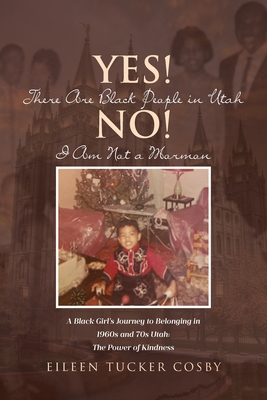Yes! There Are Black People in Utah No! I Am Not a Mormon: A Black Girl's Journey to Belonging in 1960s and 70s Utah: The Power of Kindness

Yes! There Are Black People in Utah No! I Am Not a Mormon: A Black Girl's Journey to Belonging in 1960s and 70s Utah: The Power of Kindness
In 1958, a six-pound, seven-ounce baby girl was born in Ogden, Utah. She was born "cursed" according to the teachings of The Church of Jesus Christ of Latter-day Saints (Mormons) because she was Black. Only one-tenth of one percent of people living in Utah during this time were Black. Ninety-eight percent of Utahns were white, and most of them were Mormons. Not only were Mormons taught that Black people were cursed, but that they were "loathsome and filthy" compared to white people who were considered "white and delightsome."
This book is Eileen Tucker Cosby's account of life as a young African American girl growing up in a state where people who had Black skin like her, seemed to be hated and despised - but were they? She had a wonderful, strong, and close-knit, family who loved and supported her. She lived in a happy, protected bubble for the first eight years of life until reality set in when her parents were met with resistance to living in an all-white Utah neighborhood. She struggled with isolation, self-esteem, and self-identify issues during her elementary school experience. As she began to be exposed to the Mormon faith further, she found herself confused with the kindness, sense of belonging, respect, and love that she was shown by her Mormon friends, in contrast to their Mormon teachings. Many more happy and protected bubbles would pop along the way in high school and college, including encountering one man's fantasies of her Black body in white temple clothes. How did Eileen endure the challenges she faced in Utah because of the skin she was born in and racist doctrine and teachings the Mormons believed in?
PRP: 117.49 Lei
Acesta este Prețul Recomandat de Producător. Prețul de vânzare al produsului este afișat mai jos.
93.99Lei
93.99Lei
117.49 LeiLivrare in 2-4 saptamani
Descrierea produsului
In 1958, a six-pound, seven-ounce baby girl was born in Ogden, Utah. She was born "cursed" according to the teachings of The Church of Jesus Christ of Latter-day Saints (Mormons) because she was Black. Only one-tenth of one percent of people living in Utah during this time were Black. Ninety-eight percent of Utahns were white, and most of them were Mormons. Not only were Mormons taught that Black people were cursed, but that they were "loathsome and filthy" compared to white people who were considered "white and delightsome."
This book is Eileen Tucker Cosby's account of life as a young African American girl growing up in a state where people who had Black skin like her, seemed to be hated and despised - but were they? She had a wonderful, strong, and close-knit, family who loved and supported her. She lived in a happy, protected bubble for the first eight years of life until reality set in when her parents were met with resistance to living in an all-white Utah neighborhood. She struggled with isolation, self-esteem, and self-identify issues during her elementary school experience. As she began to be exposed to the Mormon faith further, she found herself confused with the kindness, sense of belonging, respect, and love that she was shown by her Mormon friends, in contrast to their Mormon teachings. Many more happy and protected bubbles would pop along the way in high school and college, including encountering one man's fantasies of her Black body in white temple clothes. How did Eileen endure the challenges she faced in Utah because of the skin she was born in and racist doctrine and teachings the Mormons believed in?
Detaliile produsului










